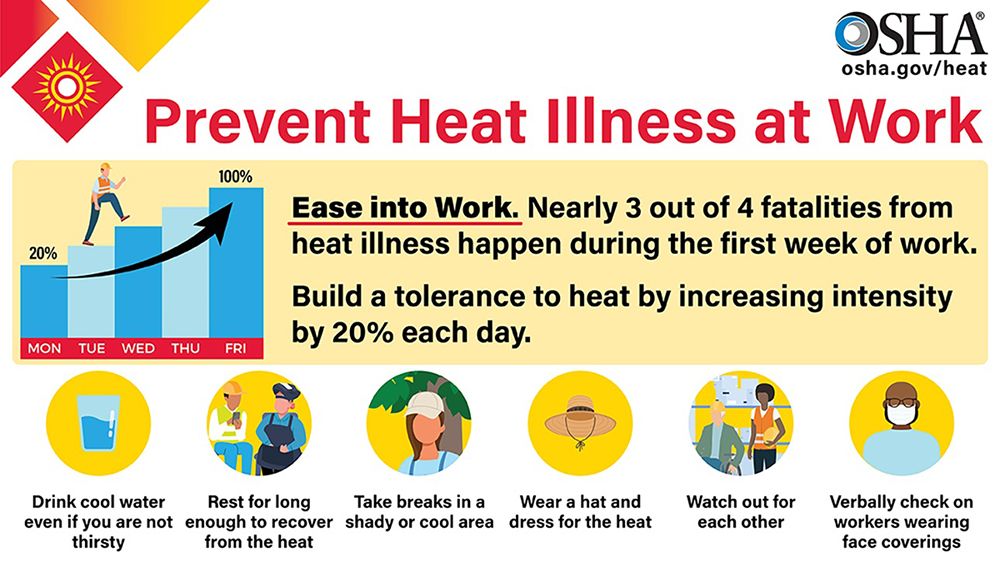Beating the Heat and Staying Safe
Summer may have just arrived, but it’s felt like summer for a good portion of the United States for some time now and service industry professionals, like those in the pest management industry, are feeling the heat.
The trusted Farmer’s Almanac call for a warm, hot, and muggy summer for most of the country and that means technicians need to be aware of the signs of heat-related illnesses and know how to reduce their exposure.
Heat Related Illnesses
Problems develop when the body’s cooling mechanisms do not work properly and the risk from heat-related illness increases. Heat rash occurs when sweat ducts become clogged and heat cramps are painful muscle spasms caused by the loss of electrolytes from heavy sweating. If you develop these conditions, immediately get out of the heat so you can rest.
When the body loses too much water and salt, heat exhaustion sets in. Signs include weakness, dizziness, nausea, headache, heavy sweating, and clammy skin. A heatstroke victim will present with a rapid pulse, hot red skin, and has stopped sweating due to lack of body fluids. The victim may show mental confusion, a decrease in alertness, and blurred judgment.
Awareness is vital to prevent heat-related illnesses as is educating employees on preventative measures, symptoms, and treatments.

How to Stay Safe in the Heat
Technicians working in the heat take can protect themselves from the dangers of hot weather and reduce the risk of heat-related illnesses by following these tips.
Hydration
Drink Plenty of Water
- Drink water frequently, even if you are not thirsty. Aim for at least 8 ounces every 15-20 minutes.
- Avoid beverages with caffeine or high sugar content as they can dehydrate you.
Electrolyte Replacement
- Consume sports drinks or electrolyte tablets to replace lost salts and minerals, especially if sweating heavily.
Clothing
Wear Appropriate Clothing
- Choose lightweight, light-colored, and loose-fitting clothing to allow better air circulation.
- Wear a wide-brimmed hat or a cap with a neck flap to protect your head and neck from the sun.
Use Sunscreen
- Apply a broad-spectrum sunscreen with an SPF of at least 30 to all exposed skin. Reapply every two hours or more often if sweating.
Work Practices
Pace Yourself
- Work at a steady pace and avoid overexertion. Gradually increase your workload to allow your body to acclimate to the heat.
- Use the buddy system to monitor each other for signs of heat stress.
- If possible, physical demands should be reduced in the heat, or heavier work scheduled for cooler times of the day.
- Rotate job functions among workers to help minimize overexertion and heat exposure.
Cooling Techniques
Use Cooling Aids
- Utilize cooling towels, vests, or bandanas soaked in cold water.
- Place a wet cloth on your forehead, neck, or wrists to help lower your body temperature.
Access to Shade
- Ensure there are shaded areas or shelters where you can rest during breaks.
- Use umbrellas or portable canopies to create shaded workspaces.
Monitoring and First Aid
Recognize Heat-Related Illnesses
- Be aware of symptoms of heat exhaustion (heavy sweating, weakness, dizziness, nausea, headache) and heat stroke (high body temperature, confusion, loss of consciousness).
- If you or a coworker show signs of heat-related illness, move to a cooler area, hydrate, and seek medical attention if necessary.
Follow Employer Policies
- Adhere to your company’s heat safety policies and procedures.
- Have an emergency plan in place that specifies what to do if a worker has signs of heat-related illness and ensures that medical services are available if needed.
PestSure – Your Partner in Safety
Founded in 1980, PestSure is the only insurance and risk management provider that is 100 percent dedicated to the pest management industry. It offers industry professionals a full suite of insurance, risk management, and safety training and education offerings.
PestSure provides insurance, safety and risk management consulting to pest management companies representing $2 billion in revenue, $750 million in payroll and more than 16,500 service vehicles. The program is administered by Alliant Insurance Services.
Call 888.984.3813 or visit our contact page for more information
When you subscribe to the blog, we will send you an e-mail when there are new updates on the site so you wouldn't miss them.



Comments